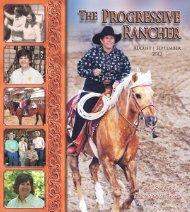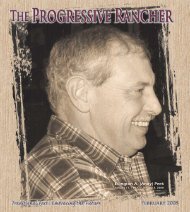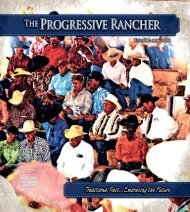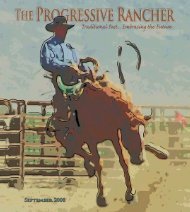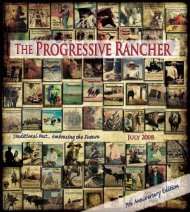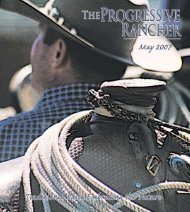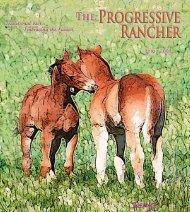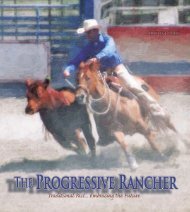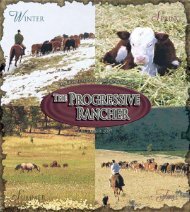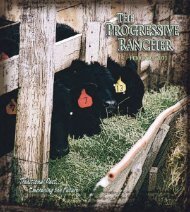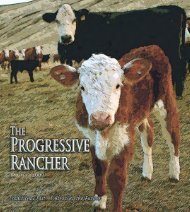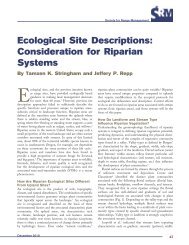nevada sage-grouse plan - Nevada Sagebrush Ecosystem Program
nevada sage-grouse plan - Nevada Sagebrush Ecosystem Program
nevada sage-grouse plan - Nevada Sagebrush Ecosystem Program
You also want an ePaper? Increase the reach of your titles
YUMPU automatically turns print PDFs into web optimized ePapers that Google loves.
STRATEGIC PLAN FOR<br />
CONSERVATION OF GREATER SAGE‐GROUSE IN NEVADA<br />
STATE OF NEVADA<br />
Brian Sandoval<br />
Governor<br />
July 31, 2012<br />
Presented To:<br />
Governor Brian Sandoval<br />
Presented From:<br />
Governor Sandoval’s<br />
Greater Sage‐<strong>grouse</strong> Advisory Committee
STRATEGIC PLAN FOR<br />
CONSERVATION OF GREATER SAGE-GROUSE IN NEVADA<br />
July 31, 2012<br />
Presented To:<br />
Governor Brian Sandoval<br />
Presented From:<br />
Governor Sandoval’s<br />
Greater Sage-<strong>grouse</strong> Advisory Committee
Strategic Plan For Conservation of Greater Sage-Grouse In <strong>Nevada</strong><br />
Table of Contents<br />
1.0 INTRODUCTION ..........................................................................................................................1<br />
1.1 GOVERNOR’S GOAL AND DIRECTIVE .......................................................................................................... 1<br />
1.2 APPROACH ............................................................................................................................................ 2<br />
BEST AVAILABLE SCIENTIFIC INFORMATION ......................................................................................... 2<br />
THREAT ASSESSMENT ........................................................................................................................... 2<br />
MAPPING ............................................................................................................................................... 2<br />
PUBLIC PARTICIPATION ......................................................................................................................... 3<br />
2.0 DEFINITIONS ...............................................................................................................................4<br />
3.0 NEVADA CONSERVATION GOALS AND STRATEGIES ......................................................................5<br />
3.1 MANAGEMENT STRATEGY IN OCCUPIED HABITAT ........................................................................................ 6<br />
3.2 MANAGEMENT STRATEGY IN POTENTIAL HABITAT ....................................................................................... 6<br />
3.3 MANAGEMENT STRATEGY IN NON-HABITAT ............................................................................................... 6<br />
3.4 INTERIM STRATEGY ................................................................................................................................. 7<br />
4.0 IMPLEMENTATION RESPONSIBILITIES ..........................................................................................8<br />
4.1 SAGE-GROUSE ADVISORY COUNCIL ........................................................................................................... 8<br />
4.2 SAGE-GROUSE TECHNICAL TEAM .............................................................................................................. 9<br />
4.3 LOCAL AREA WORKING GROUPS............................................................................................................. 10<br />
5.0 SAGE-GROUSE MANAGEMENT AREA MAP RECOMMENDATIONS ............................................... 11<br />
6.0 THREAT ASSESSMENT AND RECOMMENDED ACTIONS ............................................................... 12<br />
6.1 FIRE AND INVASIVE SPECIES ................................................................................................................... 12<br />
6.2 PINYON-JUNIPER ENCROACHMENT ......................................................................................................... 16<br />
6.3 PREDATION ......................................................................................................................................... 17<br />
6.4 WILD HORSE AND BURRO MANAGEMENT ................................................................................................ 18<br />
6.5 IMPROPER LIVESTOCK GRAZING .............................................................................................................. 18<br />
6.6 MINERAL DEVELOPMENT....................................................................................................................... 19<br />
6.7 RENEWABLE AND OTHER ENERGY PRODUCTION, TRANSMISSION AND DISTRIBUTION ...................................... 21<br />
6.8 RECREATION & OFF-HIGHWAY VEHICLE USE ............................................................................................ 21<br />
7.0 DE MINIMIS ACTIVITIES ............................................................................................................. 22<br />
8.0 MITIGATION ............................................................................................................................. 23<br />
9.0 MONITORING AND ADAPTIVE MANAGEMENT ........................................................................... 24<br />
REFERENCES .................................................................................................................................... 25<br />
Governor’s Sage-<strong>grouse</strong> Advisory Committee<br />
31 July 2012 i
Strategic Plan For Conservation of Greater Sage-Grouse In <strong>Nevada</strong><br />
LIST OF ATTACHMENTS<br />
ATTACHMENT A<br />
ATTACHMENT B<br />
ATTACHMENT C<br />
ATTACHMENT D<br />
Governor Sandoval’s Sage‐<strong>grouse</strong> Advisory Committee Membership &<br />
Governor Sandoval’s Executive Order 2012‐09<br />
Technical Presentations to the Advisory Committee<br />
Partial List of Potential Funding Opportunities<br />
Inter‐Tribal Council of <strong>Nevada</strong>, Inc. Resolution<br />
ATTACHMENT E NRCS SGI Conservation Practice Standard 528<br />
LIST OF FIGURES<br />
Figure 1. Sage‐<strong>grouse</strong> Management Areas in <strong>Nevada</strong><br />
Figure 2. Areas of Potential Development<br />
Figure 3. Wildland Fire in <strong>Nevada</strong><br />
Figure 4. Pinyon‐Juniper Encroachment in <strong>Nevada</strong><br />
Figure 5. Transmission & Renewable Energy Zones in <strong>Nevada</strong><br />
File Doc: Final Sage‐<strong>grouse</strong> Recommendations August 3 sa‐dh‐jm.doc<br />
Governor’s Sage‐<strong>grouse</strong> Advisory Committee<br />
31 July 2012 ii
Strategic Plan For Conservation of Greater Sage-Grouse In <strong>Nevada</strong><br />
List of Acronyms<br />
BLM<br />
DCNR<br />
DOD<br />
ESA<br />
IMT<br />
LAWG<br />
NAC<br />
NDEP<br />
NDF<br />
NDOW<br />
NEPA<br />
NGO<br />
NRCS<br />
RAC<br />
SGI<br />
UNR<br />
USDA – ARS<br />
USFS<br />
USFWS<br />
USGS<br />
Bureau of Land Management<br />
Department of Conservation and Natural Resources<br />
Department of Defense<br />
Endangered Species Act<br />
Incident Management Team<br />
Local Area Working Group<br />
<strong>Nevada</strong> Administrative Code<br />
<strong>Nevada</strong> Division of Environmental Protection<br />
<strong>Nevada</strong> Division of Forestry<br />
<strong>Nevada</strong> Department of Wildlife<br />
National Environmental Policy Act<br />
Non-governmental Organization<br />
Natural Resources Conservation Service<br />
Resource Advisory Councils<br />
Sage-<strong>grouse</strong> Initiative<br />
University of <strong>Nevada</strong>, Reno<br />
U.S. Department of Agriculture – Agricultural Research Service<br />
US Forest Service<br />
US Fish and Wildlife Service<br />
US Geological Service<br />
Governor’s Sage-<strong>grouse</strong> Advisory Committee<br />
31 July 2012 iii
Strategic Plan For Conservation of Greater Sage-Grouse In <strong>Nevada</strong><br />
1.0 INTRODUCTION<br />
<strong>Nevada</strong> has been proactive in conservation of greater <strong>sage</strong>-<strong>grouse</strong> since 2000 when then Governor<br />
Kenny Guinn appointed a task force representing various interest groups and agencies to develop a <strong>plan</strong><br />
that would conserve and protect <strong>Nevada</strong>’s <strong>sage</strong>-<strong>grouse</strong> and their habitat. In October 2001 the <strong>Nevada</strong><br />
Sage-<strong>grouse</strong> Conservation Strategy identified challenges, offered potential solutions, and laid the<br />
groundwork for the formation of local area working groups (LAWG) and Population Management Units<br />
(PMU). It provided guidance for developing conservation <strong>plan</strong>s and subsequent legislative endorsements<br />
in 2004 and 2010 reinforced <strong>Nevada</strong>’s commitment to conserve the species.<br />
From 2001 to 2004 the Governor’s Sage-<strong>grouse</strong> Conservation Team under leadership of the <strong>Nevada</strong><br />
Department of Wildlife (NDOW) completed an intensive <strong>plan</strong>ning effort for the state in which LAWGs<br />
developed <strong>plan</strong>s for their respective areas and PMUs. In June 2004, the 1st Edition of the Greater Sage<strong>grouse</strong><br />
Conservation Plan for <strong>Nevada</strong> and Eastern California (2004 State Plan) was completed. Between<br />
2004 and the present, resource management agencies have implemented conservation projects and<br />
instituted policies to support the conservation goals in the 2004 State Plan.<br />
On December 9, 2011, in response to the U.S. Fish and Wildlife Service’s (USFWS) inadequate regulatory<br />
mechanisms finding and to avoid a potential listing, the Bureau of Land Management (BLM) and the<br />
United States Forest Service (USFS) began a process to amend their land use management <strong>plan</strong>s<br />
affecting <strong>sage</strong>-<strong>grouse</strong> habitat to incorporate <strong>sage</strong>-<strong>grouse</strong> conservation measures. (See 76 Fed. Reg.<br />
77009 (Dec. 9, 2011); see also 77 Fed. Reg. 7178 (Feb. 10, 2012); 77 Fed. Reg. 12792 (Mar. 2, 2012).)<br />
As a step in implementing a landscape level strategy to benefit the species while maintaining a robust<br />
economy in the West, Secretary Salazar invited the states impacted by a potential <strong>sage</strong>-<strong>grouse</strong> listing to<br />
develop state-specific regulatory mechanisms to conserve the species and preclude the need for listing<br />
that could be considered as an alternative in the BLM and USFS management <strong>plan</strong> revision process. See<br />
Press Release, Salazar, Mead Reaffirm Commitment toward Development of Landscape Level Greater<br />
Sage-Grouse Conservation Strategy in the West (Dec. 9, 2011).<br />
On March 30, 2012, Governor Sandoval issued Executive Order 2012-09, which established the<br />
Governor’s Greater Sage-Grouse Advisory Committee (Advisory Committee) with a directive to provide<br />
this updated strategy and recommended approach for <strong>sage</strong>-<strong>grouse</strong> conservation in <strong>Nevada</strong>.<br />
The recommendations in this document are intended to both guide state level action as well as serve as<br />
the basis for BLM to develop an alternative in the resource management <strong>plan</strong>ning process for <strong>Nevada</strong><br />
that will ensure the conservation of <strong>sage</strong>-<strong>grouse</strong> and avoid the need to list the species.<br />
1.1 Governor’s Goal and Directive<br />
Governor Brian Sandoval’s Executive Order fortified <strong>Nevada</strong>’s commitment to <strong>sage</strong>-<strong>grouse</strong> conservation,<br />
bringing stakeholders and experts together to recommend a course of action that would conserve and<br />
enhance <strong>sage</strong>brush ecosystems and their values for all <strong>Nevada</strong>ns and meet the purpose of the<br />
Endangered Species Act (ESA).<br />
The Committee consisted of a chairman and nine appointed members representing agriculture,<br />
conservation and environmental organizations, energy development, local government, mining,<br />
Governor’s Sage-<strong>grouse</strong> Advisory Committee<br />
31 July 2012 1
Strategic Plan For Conservation of Greater Sage-Grouse In <strong>Nevada</strong><br />
ranching, sportsmen, Tribal Nations, and the general public. Members of the committee are identified in<br />
Attachment A.<br />
1.2 Approach<br />
BEST AVAILABLE SCIENTIFIC INFORMATION<br />
The Committee was informed on numerous aspects of <strong>sage</strong>-<strong>grouse</strong> management and threats during<br />
presentations made by experts and professionals in the fields of livestock grazing, predation, habitat,<br />
mitigation banking, invasive species, pinyon-juniper encroachment and other relevant topics. A list of<br />
technical experts who provided scientific information to the Committee is included in Attachment ‘B’.<br />
Committee members also conferred with their respective constituencies for current information and<br />
projections of future land uses that may be in conflict with <strong>sage</strong>-<strong>grouse</strong> habitat.<br />
THREAT ASSESSMENT<br />
The Committee identified and updated the assessment of threats to greater <strong>sage</strong>-<strong>grouse</strong> in <strong>Nevada</strong><br />
based on the analyses of the threats identified in the US Fish and Wildlife Service 2010 Finding, the 2004<br />
State Plan, population and habitat data from the <strong>Nevada</strong> Department of Wildlife (NDOW), public<br />
comment, and input from Local Area Working Groups (LAWG), and augmented expertise of individual<br />
committee members. The Committee noted that threats do not occur uniformly throughout each Sage-<br />
Grouse Management Area and specific threats should be assessed and addressed within the context of<br />
local conditions.<br />
The committee addressed the following threats from the USFWS 2010 Finding:<br />
• Wildland Fire and Invasive Species<br />
• Pinyon-Juniper Encroachment<br />
• Predation<br />
• Wild Horse and Burro Management<br />
• Improper Livestock Grazing<br />
• Mineral Development<br />
• Recreation and Off-Highway Vehicle Use<br />
• Renewable and Other Energy Production,<br />
Transmission, and Distribution<br />
MAPPING<br />
In April 2012, NDOW biologists completed a greater <strong>sage</strong>-<strong>grouse</strong> habitat map for <strong>Nevada</strong> based upon<br />
known lek locations, bird observations, telemetry data, survey and inventory reports, vegetation cover,<br />
satellite imagery data, and soil mapping. Five habitat categories included 1) Essential and Irreplaceable,<br />
2) Important, 3) Moderate, 4) Low Value or Transitional, and 5) Unsuitable. For purposes of the ongoing<br />
updates to BLM Land Use Plans and USFS Land and Resource Management Plans, BLM and USFS<br />
adapted the NDOW map by combining NDOW map Categories 1 and 2 into ‘Preliminary Priority Habitat’<br />
and using NDOW map Category 3 as “Preliminary General Habitat.”<br />
The Committee used the BLM and NDOW maps, and added a designation representing 85 percent of the<br />
core <strong>sage</strong>-<strong>grouse</strong> breeding habitat area based on statistical analyses procedures developed by Doherty,<br />
et al. (2010). The Committee proposed coarse Sage-<strong>grouse</strong> Management Areas based on the 85 percent<br />
breeding density and on June 24, 2012 these Preliminary Sage-<strong>grouse</strong> Management Area maps were<br />
submitted to LAWGs to verify and propose revisions to boundaries based on on-the-ground habitat and<br />
land use conditions.<br />
Governor’s Sage-<strong>grouse</strong> Advisory Committee<br />
31 July 2012 2
Strategic Plan For Conservation of Greater Sage-Grouse In <strong>Nevada</strong><br />
The Committee’s recommended Sage-<strong>grouse</strong> Management Area Map is discussed in Section 4.0.<br />
Mapping used in this report was based on currently compiled information. As new or more complete<br />
information becomes available, this information will be added to support this iterative <strong>plan</strong>ning process.<br />
These maps are dynamic, represent a broad-scale evaluation of habitat, and should be updated on a<br />
regular basis.<br />
PUBLIC PARTICIPATION<br />
Each Committee meeting was held in compliance with the <strong>Nevada</strong> Open Meeting Law, including multiple<br />
opportunities for public comment. Public participation for those unable to attend meetings in Carson<br />
City was facilitated through simultaneous videoconference conducted in Winnemucca, Elko, and Ely,<br />
<strong>Nevada</strong>. Local Area Working Groups participated in developing maps of Sage-<strong>grouse</strong> Management<br />
Areas. Public comment was also received through the Committee website (http://<strong>sage</strong><strong>grouse</strong>.nv.gov/)<br />
and via email sent to Committee staff and <strong>sage</strong><strong>grouse</strong>@gov.nv.gov.<br />
Governor’s Sage-<strong>grouse</strong> Advisory Committee<br />
31 July 2012 3
Strategic Plan For Conservation of Greater Sage-Grouse In <strong>Nevada</strong><br />
2.0 DEFINITIONS<br />
Area of Potential Development – Development areas where energy, mining and mineral development<br />
may need additional habitat focus and evaluation. Designations on this map should not be<br />
interpreted to imply that development will be limited only to these areas.<br />
Disturbance – Actions that will either remove or render <strong>sage</strong>-<strong>grouse</strong> habitat unusable, or human<br />
activities and presence that will cause a negative response from birds.<br />
Enhancement, Reclamation and Restoration – Actions intended to alter the vegetative features of a<br />
particular area to improve or reestablish <strong>sage</strong>-<strong>grouse</strong> habitat.<br />
Reclamation actions return an area to a functional habitat as soon as possible after disturbance, and<br />
are generally related to industrial activity.<br />
Restoration actions return an area to physical and functional habitat, often with a lapse between<br />
disturbance and replacement, usually after a natural event such as wildfire, or due to conifer<br />
encroachment, etc.<br />
Sage-<strong>grouse</strong> Management Area (Figure 1) – General, broad-scale zones that have been delineated for<br />
management and conservation of greater <strong>sage</strong>-<strong>grouse</strong>. Delineation of the Sage-<strong>grouse</strong> Management<br />
Area does not imply any degree of regulatory control or impose land-use restrictions for land-use<br />
management decisions for these lands. Within Sage-<strong>grouse</strong> Management Areas there are four levels<br />
of importance to <strong>sage</strong>-<strong>grouse</strong>. These definitions recognize all current existing land uses and<br />
previously authorized activity.<br />
• Occupied Habitat – Areas that are shown (preferably documented within the last five years) as<br />
being utilized by <strong>sage</strong>-<strong>grouse</strong>, and are essential for <strong>sage</strong>-<strong>grouse</strong> when considering the<br />
ecological components of soil, vegetation, and climate necessary to provide the biological<br />
needs of the birds at some time during their annual life cycle (breeding, nesting, brood-rearing,<br />
wintering).<br />
• Suitable Habitat – Areas that have the ecological components of soil, vegetation, and climate<br />
necessary to provide the biological needs of the birds at some time during their annual life<br />
cycle (breeding, nesting, brood-rearing, wintering). This includes Connectivity or Linkage<br />
Habitat which are areas between <strong>sage</strong>-<strong>grouse</strong> habitat or populations that are necessary to<br />
allow birds to move to seasonal ranges, or to provide opportunity for genetic variability.<br />
• Potential Habitat – Areas characterized by the appropriate ecological site description to<br />
provide additional <strong>sage</strong>-<strong>grouse</strong> habitat, sometimes through enhancement and restoration<br />
actions that can provide linkage to occupied <strong>sage</strong>-<strong>grouse</strong> seasonal habitat.<br />
• Non-Habitat – Areas that are not occupied, suitable, or potential habitat that do not provide<br />
any seasonal habitat for <strong>sage</strong>-<strong>grouse</strong>.<br />
It is recognized that <strong>sage</strong>-<strong>grouse</strong> and suitable habitat may exist outside of Sage-<strong>grouse</strong><br />
Management Areas; management policies outlined in this Strategic Plan do not apply to those<br />
areas.<br />
Governor’s Sage-<strong>grouse</strong> Advisory Committee<br />
31 July 2012 4
Strategic Plan For Conservation of Greater Sage-Grouse In <strong>Nevada</strong><br />
3.0 NEVADA CONSERVATION GOALS AND STRATEGIES<br />
The Committee recommends a strategy for <strong>Nevada</strong> that builds upon past successful efforts, expands a<br />
multi-disciplinary approach to greater <strong>sage</strong>-<strong>grouse</strong> management under the Executive Branch to include<br />
all appropriate State Agencies, and encourages closer coordination with local working groups, BLM,<br />
USFS and USFWS, and industry and interest groups.<br />
The Committee recommends the State of <strong>Nevada</strong> work to achieve conservation through a policy of “no<br />
net loss” for activities that can be controlled such as a <strong>plan</strong>ned disturbance or development. For natural<br />
disasters and acts of God such as wildland fire, the Committee recommends that the State of <strong>Nevada</strong><br />
aggressively pursue presuppression, initial attack and restoration of affected areas but believes that the<br />
State, together with its citizens and industries, should be held harmless for such occurrences that are<br />
beyond their control.<br />
The committee recommends that the overriding objective for all management actions in<br />
Sage-<strong>grouse</strong> Management Areas is to “avoid, minimize and mitigate” impacts to <strong>sage</strong>-<strong>grouse</strong><br />
habitat.<br />
This is a fundamental hierarchical decision process that seeks to:<br />
Avoid – Where ever possible, eliminate conflicts by relocating disturbance activities in order to<br />
conserve <strong>sage</strong>-<strong>grouse</strong> and their habitat.<br />
Minimize – Modify proposed actions and develop permit conditions to include measures that lessen<br />
adverse effects to <strong>sage</strong>-<strong>grouse</strong> and their habitat to the furthest extent practical such as reducing<br />
the activity footprint, seasonal avoidance, co-location of structures, etc.<br />
Mitigate – Only after all appropriate and practicable avoidance and minimization measures have<br />
been taken, offset residual adverse effects in occupied and suitable <strong>sage</strong>-<strong>grouse</strong> habitat by<br />
implementing additional actions that will result in replacement of an asset (mainly habitat) that<br />
will be lost as a result of a development action.<br />
Three general conservation policies provide the foundation and vision for a coordinated and cooperative<br />
management approach for conservation of greater <strong>sage</strong>-<strong>grouse</strong> in <strong>Nevada</strong>:<br />
1. Conserve greater <strong>sage</strong>-<strong>grouse</strong> and their habitat in <strong>Nevada</strong> consistent with maintaining economic<br />
vitality of the State.<br />
2. In areas of proposed disturbance, project proponents should first expend all means to avoid,<br />
then minimize and finally mitigate disturbance of occupied, suitable, or potential <strong>sage</strong>-<strong>grouse</strong><br />
habitat.<br />
3. Due to the broad reach of <strong>sage</strong>-<strong>grouse</strong> habitat, effective management and implementation of<br />
<strong>sage</strong>-<strong>grouse</strong> conservation actions must be conducted through a collaborative, interagency<br />
approach that engages local, private, non-governmental, state, Tribal and federal stakeholders<br />
to achieve sufficient conservation of the greater <strong>sage</strong>-<strong>grouse</strong>.<br />
The mitigation strategy recognizes impacts and threats and creates the best possible outcome for <strong>sage</strong><br />
<strong>grouse</strong>. This includes active efforts to use mitigation funding in areas where <strong>sage</strong>-<strong>grouse</strong> will derive the<br />
Governor’s Sage-<strong>grouse</strong> Advisory Committee<br />
31 July 2012 5
Strategic Plan For Conservation of Greater Sage-Grouse In <strong>Nevada</strong><br />
most benefit, even if those areas are not adjacent to or in the vicinity of impacted populations. Within<br />
Sage-<strong>grouse</strong> Management Areas, confirmation of actual conditions must be completed to understand if<br />
a proposed activity or disturbance will occur in occupied, suitable, or potential <strong>sage</strong>-<strong>grouse</strong> habitat.<br />
Sage-<strong>grouse</strong> are known to be an “umbrella species“ for many <strong>sage</strong>brush habitat-obligate and associated<br />
species. Therefore, enhancement and restoration measures that bring resiliency and restore ecological<br />
functions to <strong>sage</strong>brush-perennial grass habitats also serve to ensure quality habitat for <strong>sage</strong> thrasher,<br />
<strong>sage</strong> sparrow, Brewer’s sparrow, <strong>sage</strong>brush vole, pygmy rabbit, pronghorn antelope, mule deer and<br />
many other species.<br />
3.1 Management Strategy In Occupied Habitat<br />
1. Manage to avoid surface disturbance and habitat alteration to the greatest extent possible. If<br />
avoidance is not possible, disturbances greater than or equal to five percent of 640 acres (32<br />
acres) within occupied habitat will trigger habitat evaluations and consultation with the Sage<strong>grouse</strong><br />
Technical Team (see Section 4.2). This consultation will occur within the administrative<br />
framework of overseeing this Strategic Plan. New activities at any level of disturbance should<br />
minimize impacts to <strong>sage</strong>-<strong>grouse</strong> and their habitat.<br />
2. Limit habitat treatments in winter ranges to actions that maintain or expand current levels of<br />
<strong>sage</strong>brush available in winter.<br />
3. Proactively monitor habitat and manage to ensure that it retains the attributes necessary to<br />
support viable bird populations.<br />
4. Adequately fund aggressive documentation of habitat used by <strong>sage</strong>-<strong>grouse</strong>.<br />
3.2 Management Strategy In Potential Habitat<br />
1. Potential habitat should be used for habitat enhancement and restoration to expand or restore<br />
<strong>sage</strong>-<strong>grouse</strong> habitat that has been adversely impacted either by acts of nature (wildfire, PJ<br />
encroachment) or by human activities.<br />
2. Limit habitat disturbance, including habitat improvement projects, in potential <strong>sage</strong>-<strong>grouse</strong><br />
habitat to not more than twenty percent per year, per Sage-<strong>grouse</strong> Management Area, unless<br />
habitat treatments show credible positive results (Connelly, et al. 2000). This limit does not<br />
apply to removal of invasive or encroaching vegetation where such removal actually creates<br />
habitat.<br />
3. Potential habitat should be prioritized for enhancement, restoration, and mitigation<br />
opportunities based on data-driven models that incorporate ecological site potential where the<br />
highest priority sites have the greatest potential for successful results.<br />
3.3 Management Strategy In Non-Habitat<br />
1. Use areas designated as non-habitat within Sage-<strong>grouse</strong> Management Areas to site activities<br />
that are not geographically restricted to specific resources and to avoid investing habitat<br />
enhancement, restoration, or mitigation funds in areas with little or no potential for effective<br />
results.<br />
Governor’s Sage-<strong>grouse</strong> Advisory Committee<br />
31 July 2012 6
Strategic Plan For Conservation of Greater Sage-Grouse In <strong>Nevada</strong><br />
2. No additional management provisions are proposed for non-habitat areas within Sage-<strong>grouse</strong><br />
Management Areas.<br />
3.4 Interim Strategy<br />
1. Direct relevant State Agencies to adopt and implement the strategies and maps, and propose<br />
the policies as an interim policy for the BLM and USFS to adopt in place of their Interim<br />
Memorandum Guidance as well as an Alternative in their Land Use Plan updates and USFS<br />
Resource Management Plan updates<br />
2. Allow ongoing projects or previously authorized activities to move forward without delay.<br />
3. Allow mitigation activities to occur and be accounted for without delay.<br />
4. Designate NDOW as the primary agency for making habitat determinations consistent with this<br />
Strategic Plan, in consultation with the BLM, USFS and USFWS.<br />
5. Request federal land management agencies to work with NDOW and incorporate habitat<br />
determinations in land use decisions based on timely and complete reviews of existing<br />
information.<br />
6. Adequately fund NDOW activities to ensure compliance with the policies established in this<br />
Strategic Plan.<br />
7. Deliver a formal request to the BLM and USFS to coordinate their interim management policies<br />
in a manner consistent with the policies proposed in this Strategic Plan.<br />
8. As soon as possible, take all steps necessary to establish a functioning Sage-<strong>grouse</strong> Advisory<br />
Council and Technical Team identified in Section 4.0 of this Strategic Plan.<br />
9. Advocate for additional federal allocations for <strong>sage</strong>-<strong>grouse</strong> conservation and restoration<br />
activities.<br />
Governor’s Sage-<strong>grouse</strong> Advisory Committee<br />
31 July 2012 7
Strategic Plan For Conservation of Greater Sage-Grouse In <strong>Nevada</strong><br />
4.0 IMPLEMENTATION RESPONSIBILITIES<br />
The potential impacts of the listing of the greater <strong>sage</strong>-<strong>grouse</strong> under the ESA are well-documented. A<br />
listing decision would have significant negative impacts on the State of <strong>Nevada</strong>. Further, much action is<br />
currently underway to conserve the species – a listing decision likely could force engaged parties to<br />
cease their actions, pursue expensive litigation and stop work to conserve the greater <strong>sage</strong>-<strong>grouse</strong>.<br />
Unless listed under the ESA, management of the greater <strong>sage</strong>-<strong>grouse</strong> is the responsibility of the State of<br />
<strong>Nevada</strong>. The Committee believes that it is in the best interests of the State to propose a management<br />
strategy that the State can enact. The Committee believes that, if implemented, the recommendations<br />
in this report sufficiently conserve the species while enabling the custom, culture and economy of the<br />
State of <strong>Nevada</strong> to continue moving forward. Leadership of the State, from the highest level, has been<br />
cited as one of the major reasons for successful conservation strategy implementation and the<br />
Committee believes that it is the State’s proper role to assume leadership of this important <strong>Nevada</strong><br />
issue.<br />
4.1 Sage-<strong>grouse</strong> Advisory Council<br />
OBJECTIVE: Establish a state process to coordinate development activities in Sage-<strong>grouse</strong><br />
Management Areas. Assure that the Council has the appropriate legislative authority to<br />
oversee and implement this Strategic Plan.<br />
The Council should:<br />
1. Have membership mirroring that of the Governor’s Advisory Committee established by EO 2012-<br />
09 and provide a forum for participation from federal resource agencies including BLM, USFS,<br />
and USFWS.<br />
2. Establish the <strong>Nevada</strong> Sage-<strong>grouse</strong> Mitigation Bank program.<br />
3. Set and clarify policies and management criteria for occupied, suitable, and potential habitat<br />
areas and establish well defined decision thresholds for threat assessments and mitigation<br />
(regulatory process).<br />
4. Facilitate the resolution of conflicts between industry, land owners, and resource agencies when<br />
there is disagreement regarding <strong>sage</strong>-<strong>grouse</strong> management.<br />
5. Prepare a budget, secure and consolidate funding, and direct expenditures for <strong>sage</strong>-<strong>grouse</strong><br />
conservation.<br />
6. Pursuant to Attachment D “Inter-Tribal Council of <strong>Nevada</strong>, Inc. Resolution & Letter of Support,”<br />
integrate Tribal participation in the statewide conservation effort, and acknowledge traditional<br />
Tribal ecological knowledge when available to update Sage-<strong>grouse</strong> Management Areas.<br />
7. Establish policies for the identification and prioritization of landscape-scale enhancement,<br />
restoration, fuel reduction, and mitigation projects based upon ecological site potential, state<br />
and transition models, and other data that will contribute to decision making informed by<br />
science to increase resiliency.<br />
Governor’s Sage-<strong>grouse</strong> Advisory Committee<br />
31 July 2012 8
Strategic Plan For Conservation of Greater Sage-Grouse In <strong>Nevada</strong><br />
8. Receive and approve an annual report from the Technical Team that includes compiled and<br />
summarized data on development, enhancement, restoration, and mitigation activities in<br />
occupied, suitable, and potential <strong>sage</strong>-<strong>grouse</strong> habitat. The Council should submit the annual<br />
report to the Governor and the Public.<br />
9. Develop standards and protocols to propose to the BLM and USFS in order to facilitate<br />
expedited National Environmental Policy Act review for restoration activities in <strong>sage</strong>-<strong>grouse</strong><br />
habitat.<br />
10. Council activities should not add additional regulatory provisions or oversight for <strong>sage</strong>-<strong>grouse</strong><br />
management beyond the scope of the recommendations provided in this Strategic Plan.<br />
11. Encourage and facilitate land management education and training for all user groups of <strong>sage</strong><strong>grouse</strong><br />
habitat.<br />
4.2 Sage-<strong>grouse</strong> Technical Team<br />
OBJECTIVE: Implement a multi-disciplinary approach for administration of this Strategic Plan<br />
that incorporates scientific expertise from Federal and State agencies, and provides certainty<br />
to industry that there is a well-defined process for permitting activity in Sage-<strong>grouse</strong><br />
Management Areas.<br />
Creation of the “Technical Team” will establish a place and a process for on-the -ground decision making<br />
using the ‘Tahoe Conservation Team’ as a successful example of inter-agency team management to<br />
achieve a specific resource objective. The Technical Team should:<br />
1. Be staffed by personnel from the <strong>Nevada</strong> Department of Agriculture, the <strong>Nevada</strong> Department of<br />
Conservation and Natural Resources: Division of Forestry, Division of State Lands, Natural<br />
Heritage <strong>Program</strong>, the <strong>Nevada</strong> Department of Wildlife, and ideally, representatives from the<br />
<strong>Nevada</strong> Association of Counties, the BLM <strong>Nevada</strong> State Office, the Humboldt-Toiyabe National<br />
Forest Supervisor’s Office, the USFWS and Natural Resource Conservation Service (NRCS)<br />
2. In accordance with Council policy, oversee, administer or operate the <strong>Nevada</strong> Sage-<strong>grouse</strong><br />
Mitigation Bank program identified in this Strategic Plan.<br />
3. Identify and prioritize landscape-scale enhancement, restoration, fuel reduction, and mitigation<br />
projects based upon ecological site potential, state and transition models, and other data that<br />
will contribute to decision making informed by science to increase resiliency following wildfire.<br />
4. Foster and maintain collaborative processes with state and federal agencies to expedite<br />
permitting. Decision-making should be extended to the Technical Team such that permitting will<br />
be expedited rather than extended by an added layer of bureaucracy.<br />
5. Provide consultation for project proponents who want to conduct activities in occupied or<br />
potential <strong>sage</strong>-<strong>grouse</strong> habitat to incorporate the avoid, minimize, and mitigate practices into<br />
project designs.<br />
Governor’s Sage-<strong>grouse</strong> Advisory Committee<br />
31 July 2012 9
Strategic Plan For Conservation of Greater Sage-Grouse In <strong>Nevada</strong><br />
6. Assist the BLM and USFS as appropriate to evaluate the cumulative effects of individual small<br />
projects (less than five acres) to avoid exceeding a tolerable level of disturbance in occupied and<br />
suitable <strong>sage</strong>-<strong>grouse</strong> habitat and to determine if additional mitigation is required.<br />
7. Acquire data to refine Sage-<strong>grouse</strong> Management Areas to identify occupied, suitable, potential,<br />
and non-habitat areas.<br />
8. Solicit grants and private contributions for <strong>sage</strong>-<strong>grouse</strong> conservation projects. A partial list of<br />
potential funding opportunities in <strong>Nevada</strong> is included in Attachment C.<br />
9. Establish a geographic database repository to maintain the inventory of development and<br />
mitigation projects, population data, and monitoring results. The Technical Team will compile<br />
and summarize data annually and submit an annual progress report to the Council.<br />
10. Conduct periodic adaptive management evaluations to make management and policy<br />
recommendations to the Council.<br />
11. Project applicants should have the opportunity to conduct robust ground-truthing for the<br />
presence or absence of habitat.<br />
4.3 Local Area Working Groups<br />
The LAWGs provide all stakeholders with an opportunity to work together in actively managing and<br />
restoring landscapes across boundaries. Even with collaboration there is a realization that to be<br />
successful there is a need for more investment from all sources to achieve <strong>sage</strong>-<strong>grouse</strong> conservation<br />
objectives. LAWG membership includes representation from private land owners, tribes, federal land<br />
management agencies, local governments, USFWS, USGS, NDOW, NGOs, USDA-ARS, UNR, USDA-NRCS,<br />
DOD, sportsmen, mining, energy, OHV users, agricultural and environmental interests.<br />
The State of <strong>Nevada</strong> should:<br />
1. Formalize, support, and adequately fund operation of LAWGs under existing State Conservation<br />
Districts.<br />
2. Assure continued engagement of proven collaborative successes by charging LAWGs with<br />
responsibilities such as a) Developing and implementing site-specific <strong>plan</strong>s to accomplish<br />
enhancement and restoration projects on federal lands that are identified by the Council as<br />
areas of high importance to <strong>sage</strong>-<strong>grouse</strong>; b) Updating Sage-<strong>grouse</strong> Management Area maps; c)<br />
Monitoring; d) Identifying potential habitat enhancement and restoration projects; and e) Other<br />
tasks where local, site-specific expertise can provide added-value.<br />
Governor’s Sage-<strong>grouse</strong> Advisory Committee<br />
31 July 2012 10
Strategic Plan For Conservation of Greater Sage-Grouse In <strong>Nevada</strong><br />
5.0 SAGE-GROUSE MANAGEMENT AREA MAP RECOMMENDATIONS<br />
On July 12, 2012 the Committee utilized a collaborative process that incorporated the LAWG<br />
recommendations and additional habitat recommendations provided by NDOW to locate and designate<br />
Sage-<strong>grouse</strong> Management Areas in <strong>Nevada</strong> (Figure 1). The Sage-<strong>grouse</strong> Management Area Map defines<br />
the overall area where resources will be managed to maintain and expand <strong>sage</strong>-<strong>grouse</strong> populations. This<br />
map was further refined by the Committee on July 25 to alleviate previously unresolved conflicts.<br />
This first edition of the Sage-<strong>grouse</strong> Management Area Map is based on the best biological information<br />
and knowledge at this time, taking into account the 85 percent breeding bird density, NDOW’s<br />
Preliminary Priority and General Habitat maps, and areas of known resource conflicts. The map<br />
represents a broad-scale evaluation of habitat. Individual projects will be evaluated at the local scale.<br />
Mapping is dynamic and refinement will be a regular and ongoing process. These mapping refinements<br />
will contribute to achieving the <strong>Nevada</strong> Conservation Goals and Strategies by providing guidance to<br />
industry to consider avoidance, minimization and mitigation during the project design phase.<br />
The State of <strong>Nevada</strong> should:<br />
1. Continue with further mapping refinements as new data becomes available and landscape<br />
changes occur.<br />
2. Reconcile Sage-<strong>grouse</strong> Management Area boundaries across state lines with California, Idaho,<br />
Oregon, and Utah.<br />
3. Use areas designated as non-habitat to site activities that are not geographically restricted to<br />
specific resources and to avoid investing habitat enhancement, restoration, or mitigation funds<br />
in areas with little or no potential for effective results.<br />
4. Use existing <strong>sage</strong>-<strong>grouse</strong> telemetry data, ecological site descriptions, and state and transition<br />
models and adequate ground-truthing to further refine the Sage-<strong>grouse</strong> Management Area Map<br />
using a scientifically-defensible/robust method to map <strong>sage</strong>-<strong>grouse</strong> distribution, identify<br />
occupied, suitable, and potential seasonal habitat, and generally identify priority areas for<br />
conservation, enhancement and restoration at the landscape level to improve resiliency in<br />
<strong>sage</strong>brush ecosystems. Engage the LAWGs to provide additional mapping information and verify<br />
maps as informed by the best available information and emerging science. Pursue opportunities<br />
to acquire additional knowledge from Native American Tribes to refine mapping of occupied,<br />
suitable, and potential <strong>sage</strong>-<strong>grouse</strong> habitat.<br />
5. Recognize the previously authorized activities in Sage-<strong>grouse</strong> Management Areas. Specifically,<br />
projects with an approved BLM Notice, BLM or USFS Plan of Operation, Right of Way, Drilling<br />
Plan, or <strong>Nevada</strong> Division of Environmental Protection (NDEP) permit should be exempt from<br />
additional regulation.<br />
6. Substitute the Sage-<strong>grouse</strong> Management Area Map (Figure 1) for the map previously submitted<br />
to the USFWS.<br />
Known areas of potential development within Sage-<strong>grouse</strong> Management Areas were submitted to<br />
the Committee by industry and the general public, and compiled as shown in Figure 2.<br />
Governor’s Sage-<strong>grouse</strong> Advisory Committee<br />
31 July 2012 11
Strategic Plan For Conservation of Greater Sage-Grouse In <strong>Nevada</strong><br />
6.0 THREAT ASSESSMENT AND RECOMMENDED ACTIONS<br />
Habitat-based threats were identified to be the greatest priority statewide. Loss, degradation, and<br />
fragmentation of <strong>sage</strong>brush ecosystems from wildfire and subsequent dominance by invasive species -<br />
primarily cheatgrass and pinyon-juniper encroachment into <strong>sage</strong>brush ecological sites - were identified<br />
as the most serious threats to greater <strong>sage</strong>-<strong>grouse</strong> habitat in <strong>Nevada</strong>. In some areas, predation was<br />
identified as a direct threat to <strong>sage</strong>-<strong>grouse</strong> recruitment.<br />
6.1 Fire and Invasive Species<br />
Large and severe wildland fires in <strong>sage</strong>brush ecosystems have occurred across the state resulting in the<br />
loss of needed <strong>sage</strong>brush habit (Figure 3). This habitat degradation and loss from fire is facilitated and<br />
exacerbated by the presence of invasive species such as cheatgrass. These deteriorating landscape<br />
conditions place <strong>sage</strong>-<strong>grouse</strong> habitat as well as human lives and communities, other wildlife, water<br />
quality, and long-term soil productivity at great risk of further decline.<br />
OBJECTIVES: Actively manage Sage-<strong>grouse</strong> Management Areas across all jurisdictions with<br />
the goal of restoring the appropriate role of wildfire to establish resiliency, and actively<br />
engage in prevention, suppression and restoration of the effects of fire and invasive species.<br />
Support the development of a statewide comprehensive wildfire management program that<br />
engages all interagency partners, (federal, state & local), to reduce the threats of<br />
catastrophic wildfire, rapidly suppress wildfires when small, and rehabilitate wildfire<br />
damaged lands after a wildfire such as the <strong>Nevada</strong> Division of Forestry’s proposed “Wildland<br />
Fire Protection <strong>Program</strong>.”<br />
The following actions are recommended for State and federal agencies to improve habitat resiliency<br />
following wildfire and maintain healthy <strong>sage</strong>brush landscapes throughout Sage-<strong>grouse</strong> Management<br />
Areas:<br />
1. Establish and implement a framework across all land jurisdictions for pre-suppression actions to<br />
minimize ignitions and alter fuel conditions in order to avoid - to the extent possible - large<br />
damaging conflagrations.<br />
2. Develop and implement fire suppression <strong>plan</strong>s and strategies across all land jurisdictions for<br />
occupied and suitable <strong>sage</strong>-<strong>grouse</strong> habitat areas.<br />
3. Following fires, <strong>plan</strong> and implement <strong>sage</strong>brush enhancement and restoration treatments<br />
consistent with <strong>sage</strong>-<strong>grouse</strong> management objectives in appropriate ecological sites.<br />
4. Where appropriate, support market-based, flexible, proactive solutions that take advantage of<br />
economies of scale.<br />
Governor’s Sage-<strong>grouse</strong> Advisory Committee<br />
31 July 2012 12
Strategic Plan For Conservation of Greater Sage-Grouse In <strong>Nevada</strong><br />
Pre-Suppression Objective: Occupied and suitable <strong>sage</strong>-<strong>grouse</strong> habitat should be managed to<br />
establish resilient ecosystems by implementing the following strategies and actions to<br />
protect, maintain and improve <strong>sage</strong>brush steppe habitat.<br />
Federal, State, and Local Fire Agency Actions<br />
1. Strengthen and improve interagency wildfire prevention activities statewide through targeted<br />
wildfire prevention mes<strong>sage</strong>s including education on habitat loss, updating interagency<br />
agreements, conducting wildfire prevention workshops, and demonstration projects.<br />
2. Establish an entity that can collect and consolidate funding and develop common criteria and<br />
requirements for habitat protection and monitoring such as the Sage-<strong>grouse</strong> Advisory Council or<br />
Technical Team.<br />
3. Complete landscape level habitat assessments in, and in proximity to, priority <strong>sage</strong>-<strong>grouse</strong><br />
habitat areas to identify those habitat areas that are at the highest risk of wildland fire.<br />
4. Construct targeted, well designed fuel breaks and “green strips” to break up fuel continuity,<br />
reduce fire size, and create safe areas for fire suppression activities. Use the best adapted <strong>plan</strong>t<br />
materials to revegetate green strips with fire resistant species. Fund and schedule regular<br />
maintenance activities of green strips as needed. Avoid locating fuel breaks in occupied and<br />
suitable <strong>sage</strong>-<strong>grouse</strong> habitat unless no other options are available that will result in the same<br />
level of habitat protection.<br />
5. Support a business environment that incentivizes beneficial uses of biomass and excess fuels<br />
(e.g. stewardship contracting, landscape level/long term projects, etc.).<br />
6. Identify state and county highway/road and utility right of ways for fuel breaks, replacing<br />
invasive, fire prone species with fire resistant species and other fuels reduction treatments.<br />
7. Identify and utilize all cross-boundary authorities available to improve project coordination and<br />
implementation on the ground. Support reauthorization and expansion of ”Good Neighbor”<br />
authorities to include all states.<br />
8. Utilize NDF Conservation Camp Crews for fuels reduction project implementation and as federal<br />
grant match.<br />
Governor’s Sage-<strong>grouse</strong> Advisory Committee<br />
31 July 2012 13
Strategic Plan For Conservation of Greater Sage-Grouse In <strong>Nevada</strong><br />
Federal Agency Actions<br />
1. Review current processes and, if necessary, develop authorities and expedite the process to<br />
implement vegetative treatments for fuels reduction projects in strategic areas for protection of<br />
<strong>sage</strong>brush habitat.<br />
2. Review current processes and, if necessary, develop authorities and expedite the process to<br />
utilize a suite of active vegetative treatments (e.g. mechanical, targeted livestock grazing,<br />
prescribed fire, chemical, etc.) to reduce weed invasion and maintain resilient post-fire<br />
landscapes and control excessive fuel loading throughout the Sage-<strong>grouse</strong> Management Area<br />
and constructed fuel breaks.<br />
Suppression Objective: Manage wildland fires in the Sage-<strong>grouse</strong> Management Area to<br />
reduce the number of wildfires that escape initial attack and become greater than 300 acres.<br />
Federal, State, And Local Fire Agency Actions<br />
1. Identify and develop suppression <strong>plan</strong>s, including mapping of occupied and suitable <strong>sage</strong>-<strong>grouse</strong><br />
habitat, to improve initial attack suppression actions.<br />
2. Update Fire Management Plans, dispatch run cards, and relevant agreements to ensure “closest<br />
forces” concepts are being utilized at all times, particularly non-federal suppression resources<br />
(e.g. NDF helicopters, crews, and volunteer fire departments).<br />
3. Establish and utilize <strong>Nevada</strong> Interagency Incident Management Teams for wildfires in occupied,<br />
suitable, and potential <strong>sage</strong>-<strong>grouse</strong> habitat areas.<br />
4. Increase initial attack capability by training and equipping <strong>Nevada</strong> Volunteer Firefighters,<br />
agricultural, and industry work forces such as the Wildfire Support Group for assignment during<br />
periods of high fire activity. Trained volunteers who are remotely located should serve as first<br />
responders as necessary and appropriate.<br />
5. Integrate suppression resource locations with occupied, suitable, and potential habitat areas<br />
and pre-position resources as conditions dictate.<br />
6. Develop a “suitcase” interagency suppression task force for pre-positioning during high wildfire<br />
hazard periods.<br />
7. Within occupied, suitable, and potential habitat areas, eliminate the tactic of “burning out”<br />
unless there are direct life safety threats.<br />
Federal Agency Actions<br />
1. Utilize the interagency Fire Planning Assessment (FPA) system 1 to optimize utilization of fire<br />
suppression resources (e.g. engines, aircraft, water tenders, hand crews, etc.).<br />
1 Fire <strong>Program</strong> Analysis (FPA) enables local and national <strong>plan</strong>ners to evaluate the effectiveness of alternative fire<br />
management strategies for the purpose of meeting fire and land management goals and objectives..<br />
www.fpa.nifc.gov<br />
Governor’s Sage-<strong>grouse</strong> Advisory Committee<br />
31 July 2012 14
Strategic Plan For Conservation of Greater Sage-Grouse In <strong>Nevada</strong><br />
Federal, State, And Emergency Management Agency Actions<br />
1. Designate occupied, suitable, and potential habitat as a “high priority value” for suppression<br />
resource allocation in the Geographical Area Coordination Centers and within the FEMA-Fire<br />
Management Assistance Grant criteria.<br />
Federal And State Agency Actions<br />
1. Develop a specific and concise package of information on <strong>sage</strong>-<strong>grouse</strong> habitat for incoming<br />
Incident Management Teams (IMTs) to ensure an understanding of <strong>Nevada</strong> conservation<br />
priorities that will be included in all ‘Delegations of Authority’ and ‘Fire Management Plans.’<br />
2. Assign a local, trained resource advisor with <strong>sage</strong>-<strong>grouse</strong> expertise on all fire suppression<br />
responses in occupied and suitable <strong>sage</strong>-<strong>grouse</strong> habitat areas.<br />
Restoration Objective: Carefully review and evaluate all burned areas within Sage-<strong>grouse</strong><br />
management areas in a timely manner to ascertain the reclamation potential for<br />
reestablishing <strong>sage</strong>-<strong>grouse</strong> habitat, enhancing ecosystem resiliency, and controlling invasive<br />
weed species.<br />
Federal And State Agency Actions<br />
1. Complete burn severity assessments and identify ecological site potential in, and in proximity to,<br />
occupied, suitable, and potential <strong>sage</strong>-<strong>grouse</strong> habitat areas to identify the areas with the highest<br />
potential for restoration of habitat functions following fires. Focus rehabilitation efforts on areas<br />
of highest potential success based ecological site conditions (soils, precipitation zone, and<br />
geography). Utilize revegetation seed mixtures that include native and adapted <strong>plan</strong>t seed that<br />
will quickly stabilize soils, help to provide long term hazardous fuels reduction, and increase<br />
ecosystem resiliency in appropriate locations.<br />
2. Expand and improve the NDF Seedbank & Plant Material program in conjunction with federal<br />
partners. Utilize NDF Conservation Camp Crews for native seed collection and rehabilitation<br />
activities.<br />
3. Develop <strong>plan</strong>s and acquire the necessary resources (e.g. seed collection, seeding equipment<br />
pools, trained staff, etc.) for post fire rehabilitation activities and warehouse viable seed<br />
stockpiles.<br />
Stakeholder Actions<br />
1. Identify funding opportunities from federal, state, local, industry and land users dedicated to<br />
implementing prioritized habitat enhancement, restoration, and conservation activities.<br />
2. Continue to focus research and monitoring efforts through demonstration projects on improving<br />
rehabilitation and revegetation successes in harsh environments.<br />
Governor’s Sage-<strong>grouse</strong> Advisory Committee<br />
31 July 2012 15
Strategic Plan For Conservation of Greater Sage-Grouse In <strong>Nevada</strong><br />
6.2 Pinyon-Juniper Encroachment<br />
Pinyon-juniper encroachment is ranked as the second-highest concern in the state, and has the highest<br />
degree of reliability for habitat enhancement and restoration results in the appropriate sites identified<br />
by ecological site potential. Loss and fragmentation of <strong>sage</strong>-<strong>grouse</strong> habitat in <strong>Nevada</strong> is exacerbated by<br />
expansion of pinyon pine and juniper into <strong>sage</strong>brush habitat types (Figure 4). Encroachment from<br />
historical times occurs in large part due to fire suppression.<br />
Phases of woodland encroachment have been described as follows: Phase I, trees are present but shrubs<br />
and herbs are the dominant vegetation that influence ecological processes on the site; Phase II, trees<br />
are co-dominant with shrubs and herbs and all three vegetation layers influence ecological processes on<br />
the site; and Phase III, trees are the dominant vegetation and the primary <strong>plan</strong>t layer influencing<br />
ecological processes on the site (Tausch, et al. 2009). Recent research in <strong>Nevada</strong> shows that <strong>sage</strong>-<strong>grouse</strong><br />
actively avoid pinyon and juniper when patch sizes are greater than 200 meters wide (Coates 2012<br />
Personal Communication). Shrub cover in Phase I and Phase II sites are generally thought to be<br />
recoverable with treatments to remove invasive trees. Phase III sites cannot be recovered by removal of<br />
trees alone and require extensive restoration treatment to reestablish <strong>sage</strong>brush cover important for<br />
<strong>sage</strong>-<strong>grouse</strong> habitat.<br />
Research has found that in <strong>Nevada</strong>, 50,000 to 60,000 acres of pinyon and juniper move into a state of<br />
non-recovery (Phase III) each year. The urgency of reversing this trend cannot be overstated (Tausch<br />
Personal Communication 2012). Large areas of pinyon-juniper-encroached <strong>sage</strong>brush habitat and over<br />
stocked pinyon-juniper woodlands are in need of restoration. Overstocked stands are further stressed<br />
by vast areas of insect- and disease-caused tree mortality and are now experiencing uncharacteristically<br />
large and severe wildland fires.<br />
OBJECTIVE: Initiate landscape level treatments in potential <strong>sage</strong>-<strong>grouse</strong> habitat areas to<br />
reverse the effects of pinyon and juniper encroachment and restore healthy, resilient<br />
<strong>sage</strong>brush ecosystems.<br />
Federal, State, and Local Area Working Group Actions<br />
1. Inventory and prioritize areas for treatment of Phase I and Phase II encroachment in occupied,<br />
suitable, and potential <strong>sage</strong>-<strong>grouse</strong> habitat areas to restore habitat resiliency, reduce avian<br />
predator perches, and increase forb and grass cover.<br />
2. Prioritize areas for treatment of Phase III pinyon-juniper encroachment in strategic areas to<br />
break up continuous, hazardous fuel beds. Treat areas that have the greatest opportunity for<br />
recovery to suitable <strong>sage</strong>-<strong>grouse</strong> habitat based on ecological site potential. Old growth trees<br />
should be protected on woodland sites.<br />
Federal and State Agency Actions<br />
1. Aggressively implement <strong>plan</strong>s to remove Phase I and Phase II encroachment and treat Phase III<br />
encroachment to reduce the threat of severe conflagration and restore occupied and suitable<br />
<strong>sage</strong>-<strong>grouse</strong> habitat where possible.<br />
Governor’s Sage-<strong>grouse</strong> Advisory Committee<br />
31 July 2012 16
Strategic Plan For Conservation of Greater Sage-Grouse In <strong>Nevada</strong><br />
2. Allow temporary road access to Phase I, Phase II, and Phase III treatment areas. Construct<br />
temporary access roads where access is needed with minimum design standards to avoid and<br />
minimize impacts. Remove and restore temporary roads upon completion of treatment.<br />
3. Allocate sufficient resources to fully address habitat loss and degradation in the next ten years.<br />
4. Share project funding between all appropriate agencies and jurisdictions by designing and<br />
completing NEPA for large-scale, watershed-based treatments over a period of years, rather<br />
than ad hoc projects.<br />
5. Incentivize and assist in the development of bio-fuels and other commercial uses of pinyon and<br />
juniper resources.<br />
6. Increase the incentives for private industry investment in biomass removal, land restoration,<br />
and renewable energy development by authorizing stewardship contracts for up to 20 years.<br />
7. Establish a target goal for number of acres to be treated annually. Monitor and report progress<br />
to the Council.<br />
6.3 Predation<br />
While predator control may not be a long-term solution to declines in populations of <strong>sage</strong>-<strong>grouse</strong>, it has<br />
been shown to be an effective tool during the breeding season to gain increased survival through the<br />
nesting and early brood life cycle stages (Coates 2012). The common raven was identified as the most<br />
frequent predator during nesting in <strong>sage</strong>-<strong>grouse</strong> predator studies conducted by USGS in the Great Basin<br />
(Coates personal communication). Raven populations have increased 600 percent in the Great Basin<br />
over the last 20 years based upon USGS breeding bird survey results. Subsidized food sources such as<br />
land fills and road kill, elevated nest platforms provided by transmission lines, and landscape alterations<br />
can increase predator populations. Predation is often tied to habitat quality, particularly in areas where<br />
an interface exists between wildfire and remaining habitat.<br />
OBJECTIVE: Implement a predator control program to reduce transient raven populations for<br />
nest protection and increased chick survival throughout the interim period while habitat<br />
enhancement and restoration projects become established.<br />
Federal and State Agency Actions<br />
1. Maintain a mosaic of shrub cover conditions ranging from 20 percent to 40 percent in nesting<br />
habitat to provide both habitat resiliency and preferred nesting conditions for <strong>sage</strong>-<strong>grouse</strong> in<br />
areas with high raven populations.<br />
2. Initiate predator control programs based on biological assessments appropriate to local<br />
conditions. Conduct predator control to coincide with the life stage impacted by predation.<br />
3. Eliminate external food sources for ravens, particularly land fills, waste transfer facilities, and<br />
road kill that subsidize raven populations. Enforce existing State laws that require daily covering<br />
of landfills.<br />
Governor’s Sage-<strong>grouse</strong> Advisory Committee<br />
31 July 2012 17
Strategic Plan For Conservation of Greater Sage-Grouse In <strong>Nevada</strong><br />
4. Address and eliminate conflicting regulations between the Migratory Bird Treaty Act and the<br />
Endangered Species Act. Pursue additional take permits in excess of the current 2,000 bird limit<br />
from the USFWS for raven control.<br />
5. Identify and apply appropriate habitat management practices (e.g. livestock management,<br />
vegetation treatments, control of artificial nest and roost sites) that decrease the effectiveness<br />
of predators. Monitor effects of predator control to determine causal relations with <strong>sage</strong>-<strong>grouse</strong><br />
survivability and adapt control strategies accordingly.<br />
6. When downward population trends and nesting success are detected in occupied <strong>sage</strong>-<strong>grouse</strong><br />
habitat areas initiate predator surveys and identify responsible predator species to target and<br />
implement an effective predator control effort.<br />
6.4 Wild Horse and Burro Management<br />
Grazing by wild horses and burros and expansive herd populations can impact vegetation cover of<br />
herbaceous and shrub species, damage riparian habitat and stringer meadows, and adversely affect<br />
<strong>sage</strong>-<strong>grouse</strong> habitat if not managed within appropriate management levels (AML). Current regulatory<br />
mechanisms to manage horse herds at appropriate management levels in herd management areas are<br />
difficult to enforce due to prolonged litigation and limiting program capacity for successful placement<br />
and adoption of excess horses.<br />
OBJECTIVE: Manage wild horses at appropriate management levels (AML) to avoid and<br />
minimize impacts to Sage-<strong>grouse</strong> Management Areas.<br />
Federal Agency Actions<br />
1. Maintain wild horses at appropriate management levels in designated herd management areas<br />
(HMA) throughout Sage-<strong>grouse</strong> Management Areas.<br />
2. Evaluate conflicts with HMA designations in occupied, suitable, and potential <strong>sage</strong>-<strong>grouse</strong><br />
habitat areas and modify Land Use Plans and Resource Management Plans to avoid negative<br />
impacts to <strong>sage</strong>-<strong>grouse</strong>. If necessary, resolve conflicts between the Wild and Free Roaming<br />
Horse and Burro Act and the Endangered Species Act.<br />
6.5 Improper Livestock Grazing<br />
Livestock grazing is the most wide-spread use on pubic lands and is managed under federal agency<br />
permits, which provide schedules, numbers, areas, and adjustment clauses for drought, fire, etc.<br />
Livestock permits are monitored for permit compliance and periodically reviewed and modified as<br />
needed.<br />
Improperly managed livestock grazing is problematic to <strong>sage</strong>-<strong>grouse</strong> and can remove desired vegetation<br />
and change <strong>plan</strong>t communities from desired ecological states to undesirable states where invasive and<br />
other undesirable <strong>plan</strong>t species predominate. Where those relationships can be documented, corrective<br />
measures are best addressed through existing Standards and Guidelines identified by local Resource<br />
Advisory Committees (RAC), Local Area Working Groups, and Permit Terms and Conditions.<br />
Governor’s Sage-<strong>grouse</strong> Advisory Committee<br />
31 July 2012 18
Strategic Plan For Conservation of Greater Sage-Grouse In <strong>Nevada</strong><br />
The NRCS Sage-<strong>grouse</strong> Initiative (SGI) includes Conservation Practice Standards to alleviate threats to<br />
<strong>sage</strong>-<strong>grouse</strong> while improving the sustainability of working ranches (USFWS 2010). The Committee<br />
recognizes that proper grazing practices as described in the NRCS SGI Prescribed Grazing Practice 528<br />
(Attachment E) may be applied to improve or maintain desired species composition and vigor of <strong>plan</strong>t<br />
communities, improve or maintain quantity and quality of food and cover available for wildlife, and<br />
manage fine fuel loads to achieve desired conditions.<br />
OBJECTIVES:<br />
Ensure that existing grazing permits maintain or enhance <strong>sage</strong>-<strong>grouse</strong> habitat in Sage-<strong>grouse</strong><br />
Management Areas.<br />
Utilize livestock grazing as a management tool to improve <strong>sage</strong>-<strong>grouse</strong> habitat quantity,<br />
quality, or to reduce wildfire threats.<br />
Based on a comprehensive understanding of seasonal <strong>sage</strong>-<strong>grouse</strong> habitat requirements and<br />
in conjunction with flexibility of livestock operators, encourage land management agencies to<br />
cooperatively make timely, seasonal range management decisions to respond to vegetation<br />
management objectives, including fuels reduction.<br />
Federal Land Management Agencies and Allotment Permittee Actions<br />
1. Implement appropriate prescribed grazing conservation actions at scales sufficient to influence a<br />
positive population response in occupied and suitable <strong>sage</strong>-<strong>grouse</strong> habitat areas such as NRCS<br />
Conservation Practice Standard 528 for prescribed grazing.<br />
2. Allow flexibility in management that will utilize targeted grazing management to reduce the fuel<br />
load and fire risk to enhance and protect seasonal habitats for <strong>sage</strong>-<strong>grouse</strong>.<br />
3. Address incompatible grazing strategies when compelling and credible cause-and-effect<br />
relations have been identified cooperatively by the land management agency and the allotment<br />
permittee through rangeland management monitoring techniques appropriate in the Great<br />
Basin and consistent with <strong>sage</strong>-<strong>grouse</strong> habitat objectives.<br />
4. To the extent possible, design water developments (springs/well overflow areas, etc.) to include<br />
water and mesic habitats for <strong>sage</strong>-<strong>grouse</strong> in Sage-<strong>grouse</strong> Management Areas.<br />
5. Assess fences for high potential for bird strikes near lek areas and mark appropriately.<br />
6.6 Mineral Development<br />
Development of mineral resources in <strong>Nevada</strong> is a vital component of the State economy, and most<br />
mineral development can be managed temporally or spatially to minimize impacts to <strong>sage</strong>-<strong>grouse</strong>. The<br />
nature of mineral exploration is such that new understanding of geologic terrains, geology, geophysics,<br />
geochemistry, orogenesis, and other aspects of mineral exploration will result in areas not currently<br />
identified with exploration activity and/ or mineral potential becoming exploration targets and<br />
potentially mineral developments (i.e. mines).<br />
Governor’s Sage-<strong>grouse</strong> Advisory Committee<br />
31 July 2012 19
Strategic Plan For Conservation of Greater Sage-Grouse In <strong>Nevada</strong><br />
The mining industry has worked successfully with NDOW to <strong>plan</strong> projects that incorporate wildlife<br />
objectives. A three-year advanced <strong>plan</strong>ning window, often used at this time, allows the opportunity to<br />
incorporate avoid, minimize, and mitigate concepts in project design and to identify appropriate<br />
mitigation.<br />
OBJECTIVE: Foster a strong conservation ethic in the mining industry through<br />
implementation of effective avoidance management, and enhancement and reclamation of<br />
disturbed lands to preserve, protect, and improve habitat in occupied, suitable, and potential<br />
habitat areas.<br />
Federal and State Actions<br />
1. Implement a centralized impact assessment process overseen by the Council that provides<br />
consistent evaluation, reconciliation, and guidance for project development that avoids or<br />
minimizes conflicts with <strong>sage</strong>-<strong>grouse</strong> in occupied, suitable, and potential <strong>sage</strong>-<strong>grouse</strong> habitat.<br />
2. Consistent with BLM 43 CFR 3809 regulations for Notice-level operations and USFS 36 CFR 228A<br />
regulations governing mining and exploration, allow exploration and other mineral-related<br />
activities that create not more than five acres of surface disturbance and that are subjected to<br />
BLM and USFS existing discretionary authority to consider other information including<br />
cumulative impacts.<br />
3. Follow a strategy that seeks to avoid conflict with <strong>sage</strong>-<strong>grouse</strong> by locating facilities and activities<br />
in non-habitat wherever possible.<br />
4. Recognize existing state and federal regulatory mechanisms that govern mining and exploration<br />
activities, including BLM 43 CFR 3809 surface management regulations for hard rock mining,<br />
USFS 36 CFR 228A regulations governing mining and exploration, and NAC 519A regulations for<br />
reclamation of mining and exploration projects, that are adequate to conserve <strong>sage</strong>-<strong>grouse</strong> and<br />
<strong>sage</strong>brush habitats in the interim until future suitable conservation <strong>plan</strong>s are approved by the<br />
Council.<br />
5. Aggressively engage in reclamation efforts as projects are completed, and target reclamation<br />
where the ecological site potential exists in occupied, suitable, and potential <strong>sage</strong>-<strong>grouse</strong><br />
habitat. Focus efforts on habitat that has the greatest potential for use by <strong>sage</strong>-<strong>grouse</strong> as guided<br />
by ecological site descriptions and other restoration priorities established by the Council.<br />
6. Recognize that stipulations for other species (e.g. raptors) may impede the ability to effectively<br />
reclaim areas of impact and remove those barriers in order to achieve immediate and effective<br />
reclamation.<br />
7. Prioritize areas for habitat improvement utilizing sound resource information including soil<br />
surveys, ecological site descriptions, and <strong>sage</strong>-<strong>grouse</strong> population data.<br />
8. Design exploration projects for mineral access and the betterment of habitat. Ensure roads and<br />
other ancillary features that impact <strong>sage</strong>-<strong>grouse</strong> habitat are designed to avoid where feasible<br />
and otherwise minimize and mitigate impacts in the short and long term.<br />
Governor’s Sage-<strong>grouse</strong> Advisory Committee<br />
31 July 2012 20
Strategic Plan For Conservation of Greater Sage-Grouse In <strong>Nevada</strong><br />
9. Differentiate between short- (exploration) and long-term (active mining) impacts and manage<br />
timing of operations and physical disturbance accordingly.<br />
6.7 Renewable and Other Energy Production, Transmission and Distribution<br />
The development, transmission, and distribution of renewable and other energy sources is a high<br />
priority for the State of <strong>Nevada</strong>. Energy development can be managed spatially or temporally to<br />
minimize impacts to <strong>sage</strong>-<strong>grouse</strong>.<br />
To meet both renewable energy goals and <strong>sage</strong>-<strong>grouse</strong> conservation measures close coordination is<br />
required with various groups within the West. Transmission corridors within <strong>Nevada</strong>, such as pipelines,<br />
roads, and overhead electrical transmission/distribution lines, are generally well defined at the present<br />
time (Figure 5). There are a series of transmission corridors currently being studied to consider the<br />
longer term transmission needs required to meet the nation’s renewable energy demands.<br />
OBJECTIVE: In occupied and suitable <strong>sage</strong>-<strong>grouse</strong> habitat areas, limit conflict through<br />
avoidance and minimization of impacts, adaptive management, and appropriate mitigation.<br />
1. Follow a strategy that seeks to avoid conflict with <strong>sage</strong>-<strong>grouse</strong> by locating facilities and activities<br />
in non-habitat wherever possible.<br />
2. Site new linear features in existing corridors or, at a minimum, co-locating with existing linear<br />
features in occupied, suitable, and potential <strong>sage</strong>-<strong>grouse</strong> habitat areas.<br />
3. Aggressively engage in reclamation/weed control efforts during pre- and post-project<br />
construction.<br />
4. Apply measures to deter raptor perching and raven nesting on elevated structures.<br />
6.8 Recreation & Off-Highway Vehicle Use<br />
OBJECTIVE: In occupied, suitable, and potential <strong>sage</strong>-<strong>grouse</strong> habitat, avoid, minimize and<br />
mitigate recreation and OHV impacts to <strong>sage</strong>-<strong>grouse</strong> habitat.<br />
Numerous benefits to <strong>sage</strong>-<strong>grouse</strong> conservation may be derived from the implementation of <strong>Nevada</strong><br />
Senate Bill 394. The Act provides a mechanism and a funding source to educate users on how to<br />
responsibly use off-highway vehicles while minimizing adverse effects on public land resources including<br />
important or restricted-access to <strong>sage</strong>-<strong>grouse</strong> habitats. The Act further provides a funding source to<br />
allow the State to join with its federal partners to better <strong>plan</strong>, develop, and manage a coordinated and<br />
designated system of off-road vehicle trails in <strong>Nevada</strong>. The off-highway vehicle registration system<br />
allows state law enforcement personnel to access vehicle registration information and identify vehicle<br />
titleholders in instances where state or federal laws pertaining to off-road access or use are violated.<br />
1. Study the impact caused by recreational and OHV use in <strong>sage</strong>-<strong>grouse</strong> habitat.<br />
2. Work collaboratively through LAWGs, state, and federal agencies to designate OHV areas<br />
outside of Sage-<strong>grouse</strong> Management Areas.<br />
Governor’s Sage-<strong>grouse</strong> Advisory Committee<br />
31 July 2012 21
Strategic Plan For Conservation of Greater Sage-Grouse In <strong>Nevada</strong><br />
7.0 DE MINIMIS ACTIVITIES<br />
Existing land uses and landowner activities in greater <strong>sage</strong>-<strong>grouse</strong> occupied, suitable, and potential<br />
habitat that do not require state agency review for consistency with this Strategic Plan include the<br />
following:<br />
1. Existing animal husbandry practices including branding, docking, herding, trailing, etc.<br />
2. Existing farming practices excluding conversion of <strong>sage</strong>brush/grassland to agricultural lands.<br />
3. Existing grazing operations that utilize recognized rangeland management practices included in<br />
allotment management <strong>plan</strong>s, NRCS grazing <strong>plan</strong>s, prescribed grazing <strong>plan</strong>s, etc.<br />
4. Construction of agricultural reservoirs and aquatic habitat improvements of less than ten<br />
surface acres and drilling of agriculture and residential water wells including installation of<br />
tanks, water windmills and solar water pumps more than 0.6 miles from the perimeter of the<br />
lek. Within 0.6 miles from leks, no review is required if construction does not occur from March<br />
15 to June 30 and construction does not occur on the lek. All water tanks shall have escape<br />
ramps.<br />
5. Agricultural and residential electrical distribution lines and substations more than 0.6 miles from<br />
leks. Within 0.6 miles from leks no review is required if construction does not occur from March<br />
15 to June 30 and construction does not occur on the lek. Raptor perching deterrents should be<br />
installed on all poles within 0.6 miles from leks.<br />
6. Agricultural water pipelines if construction activities are more than 0.6 miles from leks. Within<br />
0.6 miles from leks no review is required if construction does not occur March 15 to June 30 and<br />
construction is reclaimed.<br />
7. New fencing greater than 1.25 miles from leks and maintenance of existing fencing. For new<br />
fencing within 1.25 miles of leks, fences with documented high potential for strikes should be<br />
marked.<br />
8. Irrigation (excluding the conversion of <strong>sage</strong>brush-grassland to new irrigated lands).<br />
9. Spring development if the spring is protected with fencing and enough water remains at the site<br />
to provide mesic (wet) vegetation.<br />
10. Herbicide use within existing road, pipeline and power line rights-of-way. Herbicides application<br />
using spot treatment. Grasshopper/Mormon cricket control following Reduced Agent-Area<br />
Treatments (RAATs) protocol.<br />
11. State and county road maintenance.<br />
12. Cultural resource pedestrian surveys.<br />
13. Emergency response.<br />
Governor’s Sage-<strong>grouse</strong> Advisory Committee<br />
31 July 2012 22
Strategic Plan For Conservation of Greater Sage-Grouse In <strong>Nevada</strong><br />
8.0 MITIGATION<br />
A determination of the amount and appropriate type of mitigation should be done through a consistent,<br />
timely and well-defined process, through honest communication during the impact assessment process<br />
prior to project initiation. Mitigation should be coordinated and tracked throughout and across<br />
occupied, suitable, and potential habitat areas to ensure efforts are as effective as possible and to<br />
provide feedback to the adaptive management process.<br />
OBJECTIVE: In determining appropriate and practicable measures to offset unavoidable<br />
impact, such measures should be appropriate to the scope and degree of those impacts and<br />
practicable in terms of cost, existing technology, and logistics in light of overall project<br />
purposes. The determination of what level of mitigation constitutes "appropriate" mitigation<br />
is based solely on the values and functions of the habitat that will be impacted, as<br />
practicable.<br />
1. Establish a centralized mechanism to coordinate mitigation and pre-impact mitigation across all<br />
jurisdictions and land ownerships though a mitigation program or bank that will validate, track,<br />
and monitor the success of those efforts on <strong>sage</strong>-<strong>grouse</strong> populations. By establishing this central<br />
mitigation bank, the State of <strong>Nevada</strong> will have a robust system that provides for consistent<br />
evaluation, oversight, monitoring and reporting of progress.<br />
2. In determining compensatory mitigation, the functional values lost by the resource to be<br />
impacted must be considered. In determining the nature and extent of habitat development of<br />
this type, careful consideration should be given to its likelihood of success.<br />
3. Mitigation should generally involve creation of habitat, restoration of habitat, long-term<br />
preservation of existing habitat, or enhancement of habitat to compensate for the unavoidable,<br />
residual adverse impacts of habitat disturbance.<br />
4. To ensure that mitigation efforts to create, restore or enhance habitat are not intentionally<br />
disturbed in the future, long-term conservation easements or a record of restrictive covenant<br />
should be established over the property. If public lands are used for mitigation purposes,<br />
adequate long-term maintenance or replacement of mitigation objectives must be considered<br />
while recognizing existing uses.<br />
5. Recognize and value mitigation measures that address threats, such as funding for wildfire<br />
equipment and training, predator control, radio telemetry and GPS monitoring, etc. when onsite<br />
mitigation has marginal chance for success.<br />
6. Mitigation may not be use as a method to avoid habitat impacts.<br />
7. Consideration and credit for compensatory mitigation should include habitat based efforts (i.e.<br />
<strong>sage</strong>brush habitat enhancement and restoration) along with other options such as fuels<br />
reduction, green stripping, fire suppression support and long-term habitat conservation<br />
agreements. Project proponents may receive credit for compensatory mitigation activities<br />
regardless of land ownership (i.e. federal, state or private lands).<br />
Governor’s Sage-<strong>grouse</strong> Advisory Committee<br />
31 July 2012 23
Strategic Plan For Conservation of Greater Sage-Grouse In <strong>Nevada</strong><br />
9.0 MONITORING AND ADAPTIVE MANAGEMENT<br />
Adaptive management as it relates to <strong>sage</strong>-<strong>grouse</strong> and their habitat is a structured, iterative process of<br />
robust decision making in the face of uncertainty, with an aim to reduce uncertainty over time through<br />
continued monitoring. Because adaptive management is based on a learning system, it improves long<br />
term management outcomes. The challenge in using the adaptive management approach lies in finding<br />
the correct balance between gaining knowledge to improve management in the future and achieving<br />
the best short-term outcome based on current knowledge (Allan and Stankey 2009).<br />
1. Monitoring of mitigation sites must be included in all <strong>plan</strong>s with detailed protocols to assess<br />
specific metrics and determine trends for habitat quantity and quality and <strong>sage</strong>-<strong>grouse</strong><br />
populations.<br />
2. Develop consistent monitoring protocols and methods to be used across all land jurisdictions<br />
and agencies. Compile all monitoring data into one <strong>sage</strong>-<strong>grouse</strong> database managed by the<br />
Technical Team.<br />
3. Submit all monitoring data to the centralized geographic database and compile annual reports<br />
of habitat trends.<br />
Governor’s Sage-<strong>grouse</strong> Advisory Committee<br />
31 July 2012 24
Strategic Plan For Conservation of Greater Sage-Grouse In <strong>Nevada</strong><br />
REFERENCES<br />
Allan C. and G. H. Stankey. 2009. Adaptive Environment Management: a practitioner’s guide. Dordrecht<br />
Publisher, Netherlands. ISBN 978-90-2710-8.<br />
Briske, D. D. [ed]. 2011. Conservation Benefits of Rangeland Practices: Assessment, Recommendations,<br />
and Knowledge Gaps. United States Department of Agriculture, Natural Resources Conservation<br />
Service. 429 p. Second Printing with Revisions January 2012. Available at:<br />
http://www.nrcs.usda.gov/Internet/FSE_DOCUMENTS/stelprdb1045794.pdf<br />
Coates, P. 2012. Person communication. Sage-<strong>grouse</strong> habitat recommendations. Presentation to the<br />
<strong>Nevada</strong> Sage-<strong>grouse</strong> Advisory Committee. Wildlife Biologist, U.S. Geologic Survey, Western<br />
Ecological Research Center, Sacramento, CA. Date June 19, 2012.<br />
Connelly, John W., Michael A. Schroeder, Alan R. Sands, and Clait E. Braun. 2000. Guidelines to manage<br />
<strong>sage</strong> <strong>grouse</strong> populations and their habitat. Wildlife Society Bulletin 2000, 28(4):967-985.<br />
<strong>Nevada</strong> State Legislature. 2010 Assembly Concurrent Resolution ACR No. 3 Pro-active Protection for<br />
Greater Sage Grouse in <strong>Nevada</strong><br />
<strong>Nevada</strong> State Legislature. 2005 Senate Concurrent Resolution SCR No. 15 Sage Grouse Conservation<br />
<strong>Nevada</strong> Department of Wildlife, 2004 Greater Sage Grouse Conservation Plan for <strong>Nevada</strong> and Eastern<br />
California.<br />
Tausch, R.J. 2012. Personal communication. Pinyon-juniper woodlands. Presentation to the <strong>Nevada</strong><br />
Sage-<strong>grouse</strong> Advisory Committee. Supervisory Range Scientist, USDA Forest Service Research<br />
Station, Reno, NV. Date June 18, 2012.<br />
Tausch, R.J., R.F. Miller, and J.C. Chambers. 2009. Pinyon and juniper field guide: Asking the right<br />
questions to select appropriate management actions. U.S. Geologic Survey Circular 1335. 96 p.<br />
US Fish and Wildlife Service. 2010. Conference Report for the NRCS Sage-<strong>grouse</strong> Initiative (SGI).<br />
Submitted to Dave White, Chief, USDA Natural Resources Conservation Service. Signed by R.E.<br />
Sayers, Acting Asst Director, Endangered Species <strong>Program</strong>, USDI Fish and Wildlife Service,<br />
Washington D.C. Dated July 30, 2010.<br />
Governor’s Sage-<strong>grouse</strong> Advisory Committee<br />
31 July 2012 25
Strategic Plan For Conservation of Greater Sage-Grouse In <strong>Nevada</strong><br />
ATTACHMENT A<br />
Governor Sandoval’s Sage-<strong>grouse</strong> Advisory Committee Membership<br />
Mayor Bob Crowell<br />
Carson City, <strong>Nevada</strong><br />
Bevin Lister<br />
Pioche, <strong>Nevada</strong><br />
Tina Nappe<br />
Reno, <strong>Nevada</strong><br />
Jeff Ceccarelli<br />
Reno, <strong>Nevada</strong><br />
Kent McAdoo<br />
Elko, <strong>Nevada</strong><br />
Carl Erquiaga<br />
Fallon, <strong>Nevada</strong><br />
Allen Biaggi<br />
Minden, <strong>Nevada</strong><br />
JJ Goicoechea<br />
Eureka, <strong>Nevada</strong><br />
Jack Robb<br />
Reno, <strong>Nevada</strong><br />
Beverly Harry<br />
Nixon, <strong>Nevada</strong><br />
Chairman<br />
Agriculture Representative<br />
Conservation/Environmental Representative<br />
Energy Representative<br />
General Public Representative<br />
Local Government Representative<br />
Mining Representative<br />
Ranching Representative<br />
Sportsmen Representative<br />
Tribal Nations Representative<br />
Technical assistance provided by:<br />
John McLain, Sheila Anderson, and Don Henderson, Resource Concepts, Inc.<br />
Committee Staff:<br />
Cory Hunt, Policy Analyst, Office of the Governor<br />
Governor’s Sage-<strong>grouse</strong> Advisory Committee<br />
31 July 2012 26
Strategic Plan For Conservation of Greater Sage-Grouse In <strong>Nevada</strong><br />
ATTACHMENT B<br />
Technical Presentations to the Advisory Committee<br />
Date Name and Title Presentation Title<br />
15 May 2012 Bob Budd, Executive Director<br />
Litigation and the Endangered Species Act<br />
Wyoming Wildlife and Natural Resource<br />
Trust<br />
15 May 2012 Amy Lueders, <strong>Nevada</strong> State Director<br />
Bureau of Land Management<br />
15 May 2012 Ken Mayer, Director<br />
<strong>Nevada</strong> Department of Wildlife<br />
The Wyoming Plan<br />
BLM Land Use Plans Update<br />
Interim Memorandum<br />
Bi-State Distinct Population Segment Action Plan<br />
Agency Roles and Responsibilities<br />
Western Association of Fish and Wildlife Agencies<br />
(WAFWA) and National Technical Team Reports<br />
15 June 2012 Shawn Espinosa, U<strong>plan</strong>d Game Staff<br />
Specialist<br />
<strong>Nevada</strong> Department of Wildlife<br />
15 June 2012 Leo Drozdoff, PE, Director<br />
2004 Conservation Plan<br />
Local Area Working Groups<br />
Governors’ Task Force<br />
<strong>Nevada</strong> Department of Conservation<br />
and Natural Resources<br />
11 June 2012 Quinton Barr, Range Consultant<br />
Sage-<strong>grouse</strong> and the Endangered Species Act<br />
Western Range Service<br />
11 June 2012 Ted Koch, State Supervisor<br />
Sage-<strong>grouse</strong> and the Endangered Species Act<br />
U.S. Fish and Wildlife Service<br />
18 June 2012 Jeremy Sokulsky, PE, MBA, President<br />
Mitigation Banking: Overview<br />
Environmental Incentives, LLC<br />
18 June 2012 Ted Koch, State Supervisor<br />
Predation<br />
U.S. Fish and Wildlife Service<br />
18 June 2012 Pete Anderson, State Forester<br />
Wildland Fire<br />
<strong>Nevada</strong> Division of Forestry<br />
18 June 2012 Mike Pellant, Coordinator and<br />
Rangeland Ecologist<br />
Invasive Species<br />
BLM Great Basin Restoration Initiative<br />
Governor’s Sage-<strong>grouse</strong> Advisory Committee<br />
31 July 2012 30
Strategic Plan For Conservation of Greater Sage-Grouse In <strong>Nevada</strong><br />
Date Name and Title Presentation Title<br />
18 June 2012 Dr. Robin Tausch, Supervisory Range<br />
Scientist and Plant Ecologist<br />
USDA Forest Service Research Station<br />
Pinyon Juniper Woodland<br />
18 June 2012 Dr. James Young, Senior Range Scientist<br />
(Ret.) USDA Agricultural Research<br />
Service<br />
19 June, 2012 Dr. J. Wayne Burkhardt, Range Scientist<br />
and Professor Emeritus (Ret.)<br />
Constraints of Restoration: Habitat Quantity and<br />
Quality<br />
Grazing in Sage-<strong>grouse</strong> Habitat<br />
University of <strong>Nevada</strong> Reno<br />
19 June 2012 Dr. Peter Coates, Research Biologist<br />
Predation<br />
U.S. Geological Survey<br />
2 July 2012 David Spicer, President<br />
STORM-OV, Inc.<br />
12 July 2012 Dr. Peter Coates, Wildlife Biologist<br />
Success Story: Amargosa Toad Precluded from ESA<br />
Listing<br />
Habitat Recommendations<br />
USGS Western Ecological Research<br />
Center<br />
12 July 2012 Ted Toombs, Regional Director<br />
Center for Conservation Incentives<br />
Habitat Mitigation Crediting: Market, Metrics, and<br />
Regulatory Assurances<br />
Environmental Defense Fund<br />
12 July 2012 Michael Cameron<br />
Monitoring<br />
The Nature Conservancy<br />
13 July 2012 Jim Lawrence, Administrator<br />
<strong>Nevada</strong> Division of State Lands<br />
25 July 2012 Eric Noack, Waste Management Bureau<br />
Chief<br />
<strong>Nevada</strong> Division of Environmental<br />
Protection<br />
Conservation Banking in <strong>Nevada</strong>: Tahoe Land<br />
Coverage Bank<br />
<strong>Nevada</strong> Landfill Regulations<br />
Governor’s Sage-<strong>grouse</strong> Advisory Committee<br />
31 July 2012 31
Strategic Plan For Conservation of Greater Sage-Grouse In <strong>Nevada</strong><br />
ATTACHMENT C<br />
Partial List of Potential Funding Opportunities<br />
Q-1<br />
SNPLMA<br />
Source<br />
Comment<br />
NDOW Partners in Conservation Gift Account<br />
<strong>Nevada</strong> Sportsmen Fund (Pittman-Robertson)<br />
BLM / USFS End-of-year Funds<br />
WAFWA North America <strong>Ecosystem</strong> Conservation Act<br />
Ruby Pipeline Mitigation Funds<br />
Falcon-Gondor Transmission Line<br />
<strong>Nevada</strong> Legislature<br />
Donations<br />
Conservation License Plates<br />
NRCS<br />
DOD<br />
BLM 8100 Funds<br />
Industry<br />
U.S. Fish & Wildlife Service $40,000 dedicated 7/31/12<br />
<strong>Nevada</strong> Department of Agriculture<br />
ON-line “One <strong>Nevada</strong>” Transmission Line<br />
Governor’s Sage-<strong>grouse</strong> Advisory Committee<br />
31 July 2012 32
Strategic Plan For Conservation of Greater Sage-Grouse In <strong>Nevada</strong><br />
ATTACHMENT D<br />
Inter‐Tribal Council of <strong>Nevada</strong>, Inc. Resolution<br />
Governor’s Sage‐<strong>grouse</strong> Advisory Committee<br />
31 July 2012 33
Strategic Plan For Conservation of Greater Sage-Grouse In <strong>Nevada</strong><br />
ATTACHMENT E<br />
NRCS SGI Conservation Practice Standard 528<br />
Conservation Practice Standard: Prescribed Grazing (528) (FACILITATING MANAGEMENT PRACTICE)<br />
Definition: Managing the harvest of vegetation with grazing and/or browsing animals.<br />
Purpose: This practice may be applied to improve or maintain desired species composition and vigor of<br />
<strong>plan</strong>t communities, improve or maintain quantity and quality of forage for grazing and browsing<br />
animals’ health and productivity, improve or maintain surface and/or subsurface water quality and<br />
quantity, improve or maintain riparian and watershed function, reduce accelerated soil erosion, and<br />
maintain or improve soil condition, improve or maintain the quantity and quality of food and/or cover<br />
available for wildlife, and manage fine fuel loads to achieve desired conditions. In <strong>sage</strong>-<strong>grouse</strong> habitat,<br />
this practice is critical to ensure rangelands are managed sustainably to provide habitat requirements<br />
for all life stages of <strong>sage</strong>-<strong>grouse</strong>.<br />
Resource concerns: Unrestricted livestock grazing can remove desired vegetation and change <strong>plan</strong>t<br />
communities from desired ecological states to undesirable states where invasive and other undesirable<br />
<strong>plan</strong>t species predominate. Additionally, unrestricted grazing may lead to overharvest of <strong>plan</strong>t<br />
resources, decrease residual cover, decrease <strong>plan</strong>t litter on the soil surface, increase bare ground,<br />
accelerate soil erosion rates, decrease water quality, and reduce the overall habitat quality for wildlife,<br />
including <strong>sage</strong>-<strong>grouse</strong>.<br />
Governor’s Sage-<strong>grouse</strong> Advisory Committee<br />
31 July 2012 37



